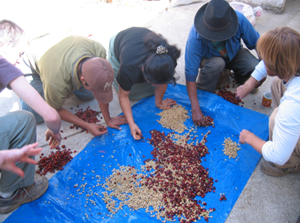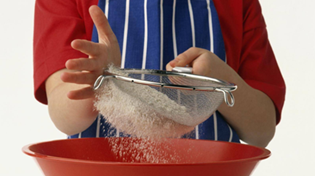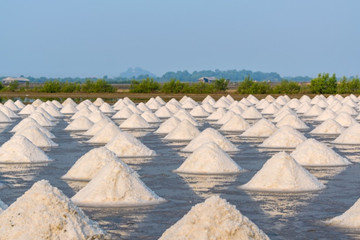CBSE Class 6 Science Notes Chapter 5 Separation of Substances
CBSE Class 6 Science Notes Chapter 5 Separation of Substances are given below. Our notes are designed by the subject experts and are as per the NCERT guidelines. These notes include all the important points of the chapter in detailed way, so you can refer to this whenever required. Study Path provides CBSE Class 6 Science Notes Chapter 5 that are easy to understand and also free downloadable PDF format, so students can practice it for their studies and get good marks in their examinations.
Water Class 6 Notes Science Chapter 5
A substance can be classified into: Mixture and the pure substance.
Pure Substances: Many substances around us contain only one type of constituent particles. Elements and compounds are pure substances. Some of the pure substances are iron, copper, water, salt, etc.
Impure Substances: Substances containing more than one type of constituent particles are called impure substances. Some of the impure substances are pond water, milk, etc.
Mixtures: A mixture is a material made up of two or more different substances, which are mixed but are not combined chemically.
Separation: Separation is the process of separating one or more components from a mixture. Example: distillation, sedimentation, filtration etc.
Need for Separation: We carry out the separation of the components of a mixture or an impure substance with the following purposes:
- To remove the unuseful or harmful component.
- To obtain the useful component.
- To remove impurities for getting a pure sample.
Principle of separation
- The substances present in a mixture retain their original properties like particle size, density, melting point, boiling point, volatility, etc.
- We use the difference in any one of these properties in the components of a mixture to separate them.
Methods of Separation: Handpicking, winnowing, sieving, magnetic separation, sedimentation, decantation, loading, filtration, evaporation, sublimation, distillation, churning, etc., are some common methods of separation.
Handpicking : The simple process of separating slightly bigger sized harmful substances or other useful substances or impurities like small pieces of stones, husk and dirt from grains of wheat, pulses and rice is called handpicking. In situations when the quantity of such impurities is not very large, handpicking turns out to be a time-saving and convenient procedure of separating substances.

Threshing: Threshing is the process of beating stalks to separate the grains from the harvested crop. It is done manually by farmers, or by threshing machines.
After the crop is harvested, stalks are left to dry under the sun. A single stalk has some 100 pieces of grain seeds joined to it. It is manually impossible to pluck each grain seed which is very small in size from the stalk and hence handpicking as a method of separation does not work here. That is why we use a method called threshing to separate these grain seeds.
Thus, Threshing can be defined as the process of separating the edible part i.e., grain seeds from the stalk by either with the help of machines, bullocks or sometimes by beating them.
Winnowing: Winnowing can be used to separate lighter and heavier components of a mixture. For example, to separate husk from grain with the help of air.
Even when threshing is done, husk or chaff is still attached to the grain seed and since the size of the two is quite similar, handpicking does not work and neither does threshing. Hence, a method called winnowing can be used.
Winnowing can be defined as the method of separating lighter husk particles and heavier grain seed components by blowing a current of air through them. The lighter husk particles are carried away by the wind and the grain seeds get separated. This husk can be further used as fodder for the cattle.
Sieving: Sieving is a method of separation in which the mixture is passed through a filter or a sieve.
Sometimes even after the grain seeds have passed through the stages of threshing and winnowing, husk may still be attached to the grain or it may have collected stones and dirt in the earlier stages which need to be removed and this separation is usually done with the help of a sieve.
Sieving is a very simple, convenient and time-saving process through which particles of varying sizes can be separated from each other with the help of a sieve. A sieve is nothing but a simple device with small pores in it which allow finer materials like flour to pass through leaving behind any impurities it might contain.

Filtration: Filtration is the process of passing the mixture through a filter to remove the solid particles from the fluid components of the mixture.
Filtration is the process through which smaller particles like dirt etc. are separated from a solution by making the solution pass through a medium (often a filter paper). This medium is such that only liquids are able to pass through it because of the presence of very tiny pores in it. The filter paper is molded to form a cone and this cone-like structure is then affixed to a funnel through which the dirty solution is allowed to pass. Sometimes, filtration can also be applied to separate pulp and seeds from the juice. It can also be used to separate cottage cheese or paneer from milk.
Sedimentation: When the heavier component in the mixture settles when water is added to it, the process is called sedimentation. This method is used in separating grains from dust and soil.
Sedimentation can be defined as the process through which dirt and other heavier particles in a mixture settle at the bottom of the vessel when water is added to it. When the dust and dirt particles have settled, the clear water which forms the upper layer is moved to a different container and the dirt and dust is done away with. This technique can also be used to separate two liquids which do not mix with each other (also called immiscible liquids) and is called decantation.
Decantation: Decantation is the process after sedimentation that involves removing the water, along with the impurities.
Decantation can be defined as a technique through which immiscible liquids or a liquid and a solid substance are separated. For example, take the case of oil and water. These are two examples of immiscible liquids. Once we pour oil in water, oil forms the upper layer of water and can be easily separated by gently pouring the mixture in another container till all the oil has been removed. Sometimes smaller dirt particles get carried along with the water in the process of decantation which needs to be further removed. This can be achieved through the process of filtration.
Condensation: The process of conversion of water vapour into its liquid form due to contact with a cooler surface is called condensation.
Example: Formation of water droplets on a metallic lid, while boiling water.
Evaporation: The process of conversion of water into its vapour is called evaporation.
Evaporation is the process of converting liquid into gas or vapour by increasing the temperature or pressure of the liquid. This process is often used to separate salt from salt water or salty sea water. Sea water has a number of salts present in it. Shallow pits called evaporation ponds are constructed and salt water is allowed to stand in these. After some time, the water gets evaporated, leaving behind the salts. Common salt is separated from this mixture upon further purification.

Can Water Dissolve Any Amount of a Substance?
Even though water can dissolve a number of substances and solutions in it, it has a limit to how much it can dissolve. After a certain point, it stops dissolving any more of that substance and the substance collects at the bottom of the vessel. We say that the solution has become saturated.
Solution: A solution is a homogeneous mixture composed of two or more substances.
- In such a mixture, a solute is a substance dissolved in another substance, known as a solvent.
Saturated solution: A saturated solution is a chemical solution containing the maximum concentration of a solute dissolved in the solvent.
- For example, a saturated solution of salt in water is that in which no more salt can be dissolved.
- This added salt will just sediment down to the bottom of the vessel.
A saturated solution is one that contains the maximum possible concentration of a particular solute. For example, if we continue to add increasing amounts of salt to a small quantity of water, there will come a point that the salt will not get mixed with the water and instead deposit at the bottom. At this point, we say that the solution has become saturated i.e. it is now incapable of dissolving any more of the given solute which is in this case, salt.
A salute is defined as a very small element in a solution that is dissolved in a solution.
One way of ensuring that the given amount of water takes more salt even after it has reached its saturation point is by heating the said water. This is because heating the solution helps to increase the solubility of salt or any solute and hence more amount of the same solute can now be dissolved in the same amount of water.
Some Important Definitions
Churning: The process of shaking milk or cream in order to allow lighter particles to come to the surface in order to make butter is called churning.
Pure Substance: This can be defined as a substance composed of only a single type of particle.
Impure Substance: A substance composed of more than one type of particles.
Sublimation: When a solid directly gets converted into vapour, this process is known as sublimation.
Magnetic Separation: This is another method of separation which allows metals (and other articles which are attracted to a magnet) to be separated from a mixture with the help of a magnetic or by applying a magnetic force to it. For example, a mixture of salt and iron filings can be separated with the help of a magnet.
Revision Notes for CBSE Class 6 Science Chapter 5 – Free PDF Download
Our Class 6 Revision Notes will provide a quick glimpse of the chapter and improve the learning experience. We have made these revision notes keeping the convenience of students in mind so that it proves more effective. You can easily read these Class 6 notes just by clicking on the chapter names provided above.